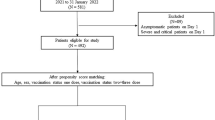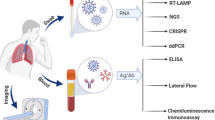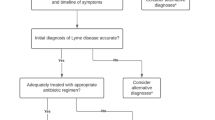Abstract
Purpose
SARS-CoV-2 infection produces lymphopenia and CD4+ T-cell decrease, which could lead to a higher risk of bacterial co-infection or impair immunological evolution in people living with HIV (PLWH).
Methods
We investigated the rate of co-infection and superinfection, and the evolution of CD4+ count and CD4+/CD8+ ratio, in hospitalized PLWH with COVID-19.
Results
From March to December 2020, 176 PLWH had symptomatic COVID-19 and 62 required hospitalization (median age, 56 years, 89% males). At admission, 7% and 13% of patients had leukocytosis or increased procalcitonin values and 37 (60%) received empiric antibiotic therapy, but no bacterial co-infection was diagnosed. There were seven cases of superinfection (12%), and one case of P. jiroveci pneumonia during ICU stay. No significant change in CD4+ count or CD4+/CD8+ ratio was observed after discharge.
Conclusion
Bacterial co-infection is not frequent in PLWH with COVID-19. Immune recovery is observed in most of patients after the disease.
Similar content being viewed by others
Background
HIV-1 and SARS-CoV-2 infections share CD4+ T-cell lymphopenia as pathogenic mechanism. Therefore, hypothetically, the presence of SARS-CoV-2 infection in people living with HIV (PLWH) could be associated with a high rate of bacterial infections or other complications, as AIDS co-infection has been associated with more severe outcomes in pandemic and seasonal influenza [1]. Furthermore, the exacerbation in CD4 T-cell drop could lead to a transient higher risk of opportunistic infections, or at least, to a fall in CD4+ count that could compromise the immune recovery in this population [2]. To evaluate this question, we assessed the rate of bacterial and opportunistic infections in PLWH during COVID-19, and the evolution of CD4+ T-cell lymphopenia after the disease.
Methods
Since March 2020, PLWH diagnosed with SARS-CoV-2 infection in our Unit were prospectively followed to ascertain clinical evolution. For the purpose of this study, we analyze the proportion of PLWH who were infected simultaneously with other pathogens during admission, and the evolution of CD4+ T-cell and CD4+/CD8+ ratio after the disease.
We included only symptomatic PLWH with a confirmed diagnosis of COVID-19 who need hospitalization. Our hospital guidelines recommended to rule out the possibility of bacterial co-infection in case of severe disease, immunosuppression, atypical clinical or radiological presentation, or increased inflammatory markers at the initial evaluation. Thus, blood, urine, or/and respiratory samples cultures, and Pneumococcal and Legionella urinary antigen tests (BinaxNOW assays, Abbott, Illinois, USA) were performed according to physician criteria at the initial evaluation.
The results of microbiological specimens taken and the use of antibiotics at admission and during hospitalization were collected. The presence of infection was considered in case of clinical or laboratory-confirmed co-infections, identified by bacterial or fungal culture of respiratory samples or blood, or through antigen detection methods or PCR detection of respiratory pathogens. Inflammatory markers were not taken into consideration in the diagnosis of infection in absence of clinical or microbiological confirmation.
Infections were divided in co-infection or superinfection according to the presence of clinical parameters and microbiological isolation of samples taken during the first 48 h since admission, or more than 48 h after, respectively. Patients were reviewed at the HIV unit a median time of 2 months after discharge (median 59 days), and CD4+ count and CD4/CD8 ratio were obtained to evaluate the changes in the immune status.
The study protocol was approved by our Institutional Review Board (EC 110/20), and patients provided oral informed consent to minimize staff exposure.
Statistical analysis
Continuous and categorical variables were presented as median (interquartile range (IQR)) and absolute number (percentage), respectively. We used the Mann–Whitney U test, chi-square test and Fisher exact test to compare differences between patients who were hospitalized, received antibiotic therapy and those who did not. Analysis of paired observations during follow-up was performed using the Wilcoxon rank signed t test. Data were analyzed using SPSS version 20.0. P value < 0.05 was taken as level of significance.
Results
From March to December 2020, 176 out of 2873 PLWH (6%) in regular follow-up in our Unit were diagnosed with COVID-19. Of them, 62 (35%) required hospitalization and were considered as the sample of interest. As expected, patients who need hospitalization were older (median, 56 vs 49 years; p = 0.003), and showed a trend to have more comorbidities (mean, 1.7 vs 1.2; p = 0.088), and a lower median nadir CD4+ (225 vs 298 cells/mm3; p = 0.097). As expected, they had a worse clinical and analytical presentation (persistent fever 71% vs 16%; p < 0.001; oxygen saturation at admission, 93% vs 97%; p = 0.001; C-reactive protein, CRP, 70 vs 15 mg/l; p < 0.001; Lactic dehydrogenase, LDH, 291 vs 181 mg/dl; p < 0.001), despite maintained virological suppression in all the cases.
Baseline characteristics of the 62 hospitalized patients are shown in Table 1. Of note, only 8 patients (13%) had procalcitonin values above 0.3 ng/ml, and 4 (7%) had peripheral blood leukocytosis (white blood cells, WBC, > 10 × 103 cells/mm3). At admission, Pneumococcal and Legionella urinary antigen test was solicited in 23 cases (38%) and blood/respiratory samples cultures in 24 (40%), in all the cases both with negative results. Thus, there were no confirmed cases of co-infection, although empiric antibiotic therapy was started in 37 cases (60%). especially in those with comorbidities. A more detailed description of patients receiving antibiotic therapy is showed in Table 1. The most used antibiotics were azithromycin (19 cases, 31%), ceftriaxone (14 cases, 23%), piperacillin–tazobactam (8 cases, 13%), and levofloxacin/amoxicillin–clavulanic (2 each, 3%) during a median time of 6 days (IQR, 5–10). Of note, both leukocyte count and procalcitonin values were significantly higher in those cases of PLWH requiring ICU care (6 cases, 10%) or who die (5, 8%).
Seven PLWH had a bacterial superinfection (12%, 95% confidence interval, CI, 3–20), associated with a prolonged hospital stay (median 24 days, IQR, 12–40). A higher proportion of ICU patients had bacterial superinfections than patients in ward settings (3/6, 50% vs 8%; p = 0.023). In detail, there were 3 cases of urinary tract infections, 4 cases of ventilator-associated pneumonia (VAP), and 2 episodes of central-line associated blood stream infection, The commonest isolated bacteria were E.faecalis (2)/faecium (1), E.cloacae (2), P. aeruginosa (2), K.pneumoniae (1) and M. morganii (1), including 3 carbapenem-resistant isolates (VAP due to E.cloacae (2) and K. pneumoniae). Two PLWH had suspicion of fungal super-infection during ICU stay (one with positive galactomannan, 1 colonized by C. krusei) but treatment was not indicated because of lack of symptoms and the high probability of colonization. There were no cases of viral infections but one case of recurrence of varicella zoster virus in a severely ill patient in the ICU. Two of the 7 patients with superinfection died during hospitalization (29%).
One PLWH (2%) developed an opportunistic infection after 39 days of hospitalization (P.jiroveci pneumonia). This was a 37-year-old female, without baseline comorbidities, with CD4+ count nadir of 453 cells/mm3 and last CD4+ value before admission of 858 cells/mm3, with respiratory worsening despite use of immunosuppressive drugs such as corticosteroids and tocilizumab, who required ICU admission and orotracheal intubation. She received adequate therapy and was discharged after 64 days.
We evaluated CD4+ T-cell count evolution after COVID-19. Overall, there were no significant changes between the last values of CD4+ count and CD4/CD8 ratio before COVID-19 disease, (median, 71 days, IQR, 41–128), and the evolution around 2 months (median time, 59 days, IQR, 38–91 days) after hospital discharge (Fig. 1A, B). Of note, 21 (38%) and 22 (40%) PLWH had a decrease in CD4+ count and CD4/CD8 ratio during COVID-19 that persisted after the disease, and albeit not significant, this CD4+ count decrease was more frequently observed in those with nadir CD4+ count < 200 cells /mm3 (45% vs 30%), previous AIDS-defining illness (46% vs 33%) or more severe disease at admission (55% vs 33%).
A CD4+ T-cell count in PLWH with symptomatic, confirmed SARS-CoV-2 infection who required hospitalization: nadir CD4+ count (left, gray circles, 62 patients), last value before admission a median of 71 days (center, dark gray squares), and the same individuals a median of 59 days after the disease (right, gray triangles, 57 cases). Each dot represents an individual. Lines represent group median and interquartile range. Comparison was performed by Wilcoxon signed rank test. B CD4/CD8 ratio before COVID-19 admission (left) and around 2 months after they have overcome the disease (right). Boxes represent median and interquartile range. Discontinued lines between points indicate individual changes for 57 PLWH (5 patients died during COVID-19 admission). Comparison was performed by Wilcoxon signed rank test
Discussion
Co-infections in COVID-19 have been described in previous studies but reported incidence varies greatly, according to definition criteria and the diagnostic methods used [3, 4]. Our study, the first evaluating the burden of co-infections, AIDS-related diseases, and persistence of immunodepression in PLWH with confirmed SARS-CoV-2 infection, indicated that co-infections are rare in well-controlled PLWH, independently of the CD4+ drop associated with acute disease.
This fact is not unexpected, as only 3–7% of bacterial co-infections have been described in the general population, predominantly in older patients [5, 6]. Furthermore, less than 13% of our PLWH had alteration in inflammatory serological markers such as procalcitonin or leukocytosis, parameters usually associated with bacterial infection, even using a low procalcitonin threshold value [7]. Indeed, although these markers were associated with ICU admission or mortality, it has been demonstrated that they could be increased in patients with COVID-19 without a corresponding bacterial co-infection occurring [8].
Notably, the majority of our cohort received empiric antibiotic treatment with azithromycin or ceftriaxone at hospital admission. This extended use of antibiotic has been already described in the general population, and it could be associated with emergence of resistance in subsequent infections [9]. In our cohort, superinfections were observed in 12%, a similar incidence than that observed in the general population (14%) [3], related to prolonged hospitalization and ICU stay, as we observed. Of clinical importance, multi-resistant bacteria were frequently isolated.
There are some concerns that concomitant SARS-CoV-2 and HIV infection increase the risk of complications associated with immunodepression, since both share lymphopenia and CD4+ T-cell decrease as pathogenic mechanisms, In spite of 30% of severe lymphopenia at admission, we only observed one unexpected case of P. jiroveci pneumonia in a PLWH with previous high CD4+ count, after 39 days of admission and ICU stay, probably related to the use of immunosuppressive drugs.. This unusual co-infection has been described as co-infection or even as debut of HIV [10], and it should be considered in cases with clinical impairment after prolonged hospitalization, even in absence of previous immunosuppression. On the other hand, we demonstrated a return to baseline values in CD4+ count and CD4/CD8 ratio after COVID-19, even in an important proportion of those PLWH with a low level before infection. This fact suggests the lack of immunological sequelae in most of the cases, at least in terms of CD4+ T-cell count.
Our study acknowledged some limitations. The study was limited to one center and to a low number of PLWH, and results could change by considering that 8% of patients died during hospitalization. On the other hand, this limitation allowed us to have consistency in management of patients and antimicrobial policies. Second, despite that there were general recommendations for screening COVID-19 patients for bacterial co-infection, request of blood cultures or urinary antigen tests for respiratory pathogens relied on physician judgement. Therefore, empirical antimicrobial treatment could have masked the presence of bacterial co-infections in some cases. Finally, this study was carried out before predominance of the new variants of concern (VOC), such as the more aggressive delta variant and therefore, the rate of bacterial co-infection or the repercussions in the immune status could be now different.
In conclusion, we showed that bacterial co-infection was unusual in well-controlled PLWH with COVID-19, suggesting that empirical antimicrobial treatment could be not necessary in PLWH. Furthermore, our findings suggest that COVID-19 does not impact the immune recovery in most PLWH after the disease.
References
Joseph C, Togawa Y, Shindo N. Bacterial and viral infections associated with influenza. Influenza Other Respir Viruses. 2013;7:105–13. https://doi.org/10.1111/irv.12089.
Peng X, Ouyang J, Isnard S, Lin J, Fombuena B, Zhu B, et al. Sharing CD4+ T cell loss: when COVID-19 and HIV collide on immune system. Front Immunol. 2020;11:596631. https://doi.org/10.3389/fimmu.2020.596631.
Lansbury L, Lim B, Baskaran V, Lim WS. Co-infections in people with COVID-19: a systematic review and meta-analysis. J Infect. 2020;81:266–75. https://doi.org/10.1016/j.jinf.2020.05.046.
Rawson TM, Ming D, Ahmad R, Moore LSP, Holmes AH. Antimicrobial use, drug-resistant infections and COVID-19. Nat Rev Microbiol. 2020;18:409–10. https://doi.org/10.1038/s41579-020-0395-y.
Garcia-Vidal C, Sanjuan G, Moreno-Garcia E, Puerta-Alcalde P, Garcia-Pouton N, Chumbita M, et al. Incidence of co-infections and superinfections in hospitalized patients with COVID-19: a retrospective cohort study. Clin Microbiol Infect. 2021;27:83–8. https://doi.org/10.1016/j.cmi.2020.07.041.
Sepulveda J, Westblade LF, Whittier S, Satlin MJ, Greendyke WG, Aaron JG, et al. Bacteremia and blood culture utilization during COVID-19 surge in New York City. J Clin Microbiol. 2020. https://doi.org/10.1128/JCM.00875-20.
Rodriguez AH, Aviles-Jurado FX, Diaz E, Schuetz P, Trefler SI, Sole-Violan J, et al. Procalcitonin (PCT) levels for ruling-out bacterial coinfection in ICU patients with influenza: a CHAID decision-tree analysis. J Infect. 2016;72:143–51. https://doi.org/10.1016/j.jinf.2015.11.007.
Wan S, Xiang Y, Fang W, Zheng Y, Li B, Hu Y, et al. Clinical features and treatment of COVID-19 patients in northeast Chongqing. J Med Virol. 2020;92:797–806. https://doi.org/10.1002/jmv.25783.
Rawson TM, Moore LSP, Castro-Sanchez E, Charani E, Davies F, Satta G, et al. COVID-19 and the potential long-term impact on antimicrobial resistance. J Antimicrob Chemother. 2020;75:1681–4. https://doi.org/10.1093/jac/dkaa194.
Menon AA, Berg DD, Brea EJ, Deutsch AJ, Kidia KK, Thurber EG, et al. A case of COVID-19 and Pneumocystis jirovecii coinfection. Am J Respir Crit Care Med. 2020;202:136–8. https://doi.org/10.1164/rccm.202003-0766LE.
Acknowledgements
We would like to thank Ana Abad for her contribution in database management.
Funding
No specific funding was received for this work.
Author information
Authors and Affiliations
Contributions
JLC, and PV, conceived and designed the study, and were responsible for patient enrollment, follow-up, data analysis, and drafted and finalized the article; AM, MJV, JM, MJP-E and AV. were responsible for patient enrollment, clinically followed up patients, and helped to write the work. All coauthors revised the manuscript and read and approved the final version.
Corresponding author
Ethics declarations
Conflict of interests
MJPE has received research grants or honoraria for lectures or for participation in advisory boards from Abbott, Bristol-Myers Squibb, Gilead Sciences, ViiV Healthcare and Janssen; and unrestricted grants from Abbott, ViiV Healthcare, Gilead Sciences and Janssen. For the remaining authors no conflict of interest was declared. All research was conducted within the guidelines of ethical principles, and local legislation.
Rights and permissions
About this article
Cite this article
Casado, J.L., Vizcarra, P., Vivancos, M.J. et al. Low risk of bacterial co-infection, opportunistic diseases, and persistent immunosuppression in people living with HIV and COVID-19. Infection 50, 1013–1017 (2022). https://doi.org/10.1007/s15010-022-01811-0
Received:
Accepted:
Published:
Issue Date:
DOI: https://doi.org/10.1007/s15010-022-01811-0





